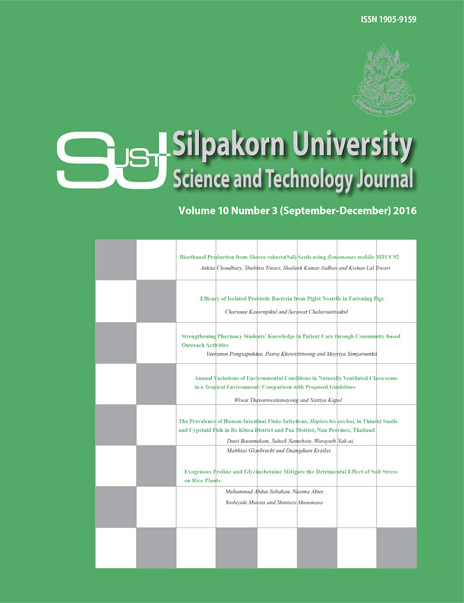Efficacy of Isolated Probiotic Bacteria from Piglet Nostrils in Fattening Pigs
Main Article Content
Abstract
Probiotics applications in animal husbandry can increase feed intake, growth and immune responses. The aim of this study was to isolate the probiotic bacteria from piglet nostrils and test their efficacy in fattening pigs. Nasal swabs collected from 110 healthy piglets were processed on Man, Rogosa and Sharpe (MRS) agar plates for lactic acid bacteria isolation. The biochemical standard tests were used for identification of isolates organisms including: Gram staining, catalase production, tolerance to bile salts, acid and base and the utilization of proteins, starch and fat. The antimicrobial activity and resistance against antibiotics were also determined. Comparative 16S rRNA analysis confirmed the identity of selected strains as Enterococcus italicus. Thirty weaned piglets (mixed sex and 35-day old) were divided into three groups (five replicates with two animals) consisting of a control group, a positive control group fed with commercial feed and antibiotic, and an experimental group fed with commercial feed and probiotics. Porcine reproductive and respiratory syndrome (PRRS) vaccination were performed twice. Administration of Enterococcus italicus had no impact on average daily gain, whereas it affected feed intake and feed conversion ratio (p < 0.05). The experimental and positive control groups were differed significantly from the control group regarding the level of immunity (p > 0.05).
Downloads
Article Details
References
Davis, M. E., Parrott, T., Brown, D. C., de Rodas, B. Z., Johnson, Z. B., Maxwell, C. V., and Rehberger, T. (2008). Effect of a Bacillus-based direct-fed microbial feed supplement on growth performance and pen cleaning characteristics of growing- finishing pigs. Journal of AnimaScience, 86(6): 1459-67.
Deprez, P., Van den Hende, C., Muylle, E., and Oyaert, W. (1986). The influence of the administration of sow’s milk on the post-weaning excretion of hemolytic E. coli in the pig. Veterinary Research Communications, 10(6): 469-478.
Fortina, M. G., Ricci, G., Borgo, F., Manachini, P. L., ends, K., Schiwon, K., Abajy, M. Y., and Grohmann, E. (2008). A survey on biotechnological potential and safety of the novel Enterococcus species of dairy origin, E. italicus. International Journal of Food Microbiology, 123(3): 204-211.
Gilliland, S. E., Staley, T. E., Bush L. J. (1984). Importance of bile tolerance of Lactobacillus acidophilus used as a dietary adjunct. Journal of Dairy Science, 67(12):3045-3051.
Isolauri, E., Joensuu, J., Suomalainen, H., Luomala, M., and Vesikari, T. (1995). Improved immunogenicity of oral DxRRV reassortant rotavirus vaccine by Lactobacillus casei GG. Vaccine, 13(3):310-312.
Jens, N. J., and Hansan Chr. (2006). Probiotics for pigs-reliable solutions. Pig topics, 2(7): 7–9.
Kasornpikul, C., Chaiyasut, C., Sirithanyalug, B., Aeagwanich, W., and Pewnim, T. (2008). Probiotics properties of bacteria isolated from poultry in thailand. In Proceeding of ISSAAS international congress, Bangkok, Thailand.
Kritas, S. K., and Robert, B. M. (2006). Effect of orally administered Lactobacillus casei on porcine reproductive and respiratory syndrome (PRRS) virus vaccination in pigs. Veterinary Microbiology, 119 (2–4): 248–255.
Larpent, J. P., and Larpent, M. (1985). Manuel pratique de Microbiology. Paris: Herman.
Lessard, M., and Brisson G. J. (1987). Effect of A Lactobacillus fermentation product on Growth, immune response and fecal enzyme activity in weaned pigs. Canadian Journal of Animal Science, 67(2): 509-516.
Sirichokchatchawan, W., Chalermchaikit, T., and Prapasarakul, N. (2014). The role of Probiotic in swine industry. [OnlineURL:www.micro.vet.chula.ac.th/attachments/131_Probiotic.pdf] accessed on October 10,2015.
Sittigool, P. (2014). Swine Production. [Online URL: courseware.rmutl.ac.th/courses/110/unit000.html] accessed on October 10,2015.
Reque, E. F., Pandey, A., Franco, S. G. and Soccol, C. R. (2000). Isolation, Identification and Physiological study of Lactobacillus fermentum LPB for use as Probiotic in Chickens. Brazilian Journal of Microbiology, 31(4) :303-307 [Online URL: https://www.scielo.br/pdf/bjm/v31n4/a12v31n4.pdf] accessed on October 10,2015.
Salminen, S., Bouley, M. C., Boutron-Rualt, M. C., Cummings, J., Franck, A., Gibson, G., Isolauri, E., Moreau, M.-C., Roberfroid, M., and Rowland, I. (1998). Functional food science and gastrointestinal physiology and function. British Journal of Nutrition, 80(1): 147–171.
Timbuntam, W., Rodprapakorn, M., Sassanarakkit, S., Jareonkitmongkol, S., and Saman, P. (2001). Screening of microorganisms as probiotic for feeding giant freshwater prawn (Macrobrachium rosenbergi). In Proceedings of the 39th Kasetsart University Annual Conference: Fisheries, Agro-Industry, Bangkok, Thailand.
Strompfová, V., Marcináková, M., Simonová, M., Gancarcíková, S., Jonecová, Z., Sciranková, L., Koscová, J., Buleca, V., Cobanová, K., and Lauková, A. (2006). Enterococcus faecium EK13—an enterocin A-producing strain with probiotic character and its effect in piglets. Anaerobe, 12(5-6): 242-248
Xuan, Z. N., Kim, J. D., Heo, K. N., Jung, H. J., Lee, J. H., Han, Y. K., Kim, Y. Y., Han, In K. (2001). Study on the development of a probiotics complex for weaned pigs. Asian-Australasian Journal of Animal Sciences, 14(10): 1425-1428.
Van de Vyver, S., D’Hondt, E., Sels, B. F., and Jacobs, P. A. (2010) .Preparation of Pt on NaY zeolite catalysts for conversion of glycerol into 1,2-propanediol. Studies in Surface Science and Catalysis, 175: 771-774.
Witsuthammakul, A., and Sooknoi, T. (2012). Direct conversion of glycerol to acrylic acid via integrated dehydration–oxidation bed system. Applied Catalysis A: General, 413-414: 109-116.
Zakaria, Z. Y., Linnekoski, J., and Amin, N. A. S. (2012). Catalyst screening for conversion of glycerol to light olefins. Chemical Engineering Journal, 207-208: 803-81.


